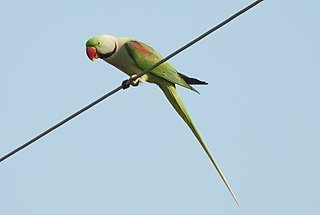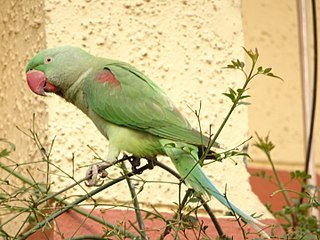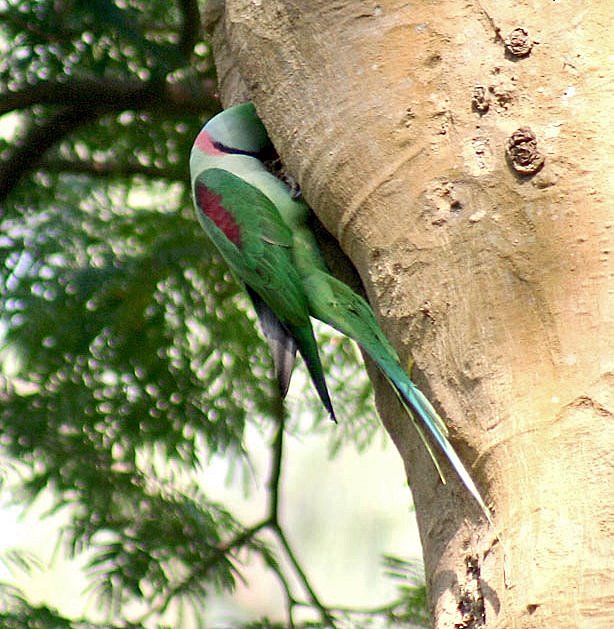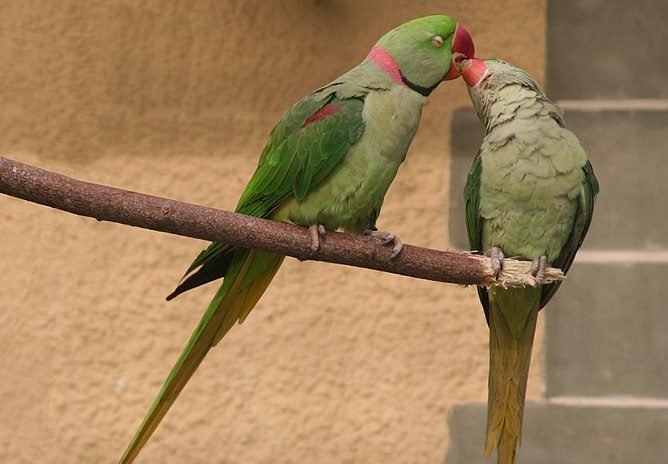Alexandrine parakeets (or Alexandrine parrots) are one of the more common pet parrot species in the world. They are easy to train and, once they comfortably settle in, they become quite tame and well-behaved yet quirky and entertaining addition to the family.
If you’re a bird keeper and happen to have Alexandrine parakeets, you might be thinking about what the breeding process is like. When is their mating season? What is the process of raising a baby chick? Here you can find all of the answers to the questions regarding Alexandrine Parrot breeding.
Alexandrine parakeet gender differences
Maybe you’ve adopted your parrot whilst they’re still very young and now you’re asking yourself -How can I tell if my Alexandrine Parakeet is male or female? Luckily, these species are dimorphic bird species, meaning that there are clear visual differences between the male and the female Alexandrine parakeet.
Young Alexandrine parakeets don’t differ much in gender, although females often have a longer tail than males do. When they reach adulthood and reproductive age, male Alexandrine Parakeets feature a pink band on their nape, as well as a black stripe across their lower cheeks. Females lack both.

Alexandrine parrot Male 
Alexandrine parrot Female
Photo Credit: Dr. Raju Kasambe / CC BY-SA (https://creativecommons.org/licenses/by-sa/4.0)
Alexandrine Parakeets do not reach full sexual maturity until they are three years of age when the first breeding attempts begin.
More about Gender difference here:
https://parrotquaker.com/alexandrine-parakeet-gender-difference/
Alexandrine parakeet mating season
They breed in their native range from November to April. Across many countries in Europe, feral populations tend to start breeding as early as February.
The bonding between the male and the female takes place during the whole winter prior. Parakeets do not just find a mate and proceed to breed with them – males court their partner by displaying their wings whilst stretching, bowing, eye flashing, as well as giving the female lots of attention and food because females are usually more reluctant towards breeding while being the more dominant gender in the group. Female dominance is also the reason as to why male and female parakeets don’t get along as well before the time of courtship.
Once the male has gained the trust of the female and established a connection with her, they can begin the breeding process when mating season arrives.
Alexandrine Nesting
In the wild, they usually nest in tree hollows, but in urban areas, they might substitute them for cracks in buildings. Sometimes, if there is no appropriate tree hollow nearby, they will excavate them on their own.
A female lays between two to four eggs measuring at around 1×1.3in. There is usually only one single clutch per season. The laying process can last one week, while the subsequent incubation period is somewhere between three to four weeks.

In captivity, Alexandrine parakeets are fairly easy to breed. You just need to set your male and female in an appropriate environment before the mating season begins.
A proper nest box is crucial
It shouldn’t be too big so that they don’t recognize it as a cozy nesting box, but it shouldn’t be too small so that they don’t have the space to move around comfortably. The depth of the nest box should be somewhere between 24 and 40 inches. It’s best to make a vertical nest box where the lower half will be used for nesting.
The entrance should be on top and should be a 4×4 inch hole. When the holes are too big, the Parakeets might not deem the nest-box as safe. The bottom half should feature an inspection hole with a door – just for safety precautions.
The top should also feature a removable lid so that you have better access in emergency situations or simply to clean the nest if needed.
The nesting box should be elevated from the ground, but not too close to the roof or ceiling of the house to avoid heat fluctuation issues.
Insert some sort of climbing structure into the nesting box, like a ladder or multiple poles.
The material in the nest box should be organic but soft, like wood shavings or decomposed non-toxic sawdust.
It would maybe be a good idea to place several nesting boxes and let the future parents decide which one they like best.
Another thing you can do to enable the breeding process aside from isolating the male and female in an enclosure with a nest box is to provide their favorite foods. Alexandrine parakeets are omnivorous in nature. In captivity, their diet can consist of a large variety of seeds and grains, fruit and vegetables, whole grain bread, eggs for protein… Sprouted seed and cuttlebone are essential because they contain all the nutrients the female needs during the breeding season. A male can also feed the female to establish a greater connection with her.
Baby chick growth stages
Stage one – neonate/hatchling
This stage lasts for about three to four weeks. It’s the stage after which the baby chicks first hatched. They still have their eyes closed and need extra warmth and shelter.
Stage two – nestling
This stage also lasts three to four weeks. It’s after the bird opens its eyes, but it still can’t feed on its own. At this stage, the baby chicks become more curious and start waddling on their own. This is the stage at which it becomes safe to remove the babies from their enclosure if you wish to do so. If they spend some time with humans while they’re nestlings, they are more likely to learn words early on.
Stage three – fledging
This is a stage during which they learn how to fly. They might become more interested in flying than exploring food options, so they need close monitoring.
Stage four – weanling
This is the stage where a parrot learns how to feed on their own. Depending on how long it took the baby chicks to learn how to fly, weanling can last anywhere between three to six weeks.
Stage five – juvenile
This is the stage, also called “pre-adolescent age” during which the babies become independent, but still do not reach full maturity.
Transitional stages
After the juvenile stage, baby parakeets tend to go into a so-called bluffing or juvenile biting stage where they are more irritable. This is essentially parrot puberty and it happens between the ages of four months to one year. After this, Alexandrine parakeets reach full sexual maturity between the ages of three and four.
After they’ve hatched, Alexandrine chicks enter fledging age at around seven weeks, after which they stay co-dependent on their mother for about another month.
Raising Alexandrine baby chick
If you want your new clutch of chicks to take the natural course, you do not need to intervene much. As long as you provide the enclosure with proper food and water, your adult parakeets will take care of the rest.
The male usually stays with the female in the nest box and helps provide for the young ones. Alexandrine parakeets are instinctively very good parents.
Although they are very affectionate birds and have unquestionable parenting skills, sometimes they may become aggressive towards their offspring. This usually happens if the baby birds stay too co-dependent from their parents and exhibit clingy behavior after three months of age.
In this case, the parents will try to attack their young, and the clutch should be separated from the adults until they both settle down individually.
If the young are hand-raised from just before when they enter fledging, a second clutch of eggs might appear before the end of the season. Although it’s very rare, some pairs will also attempt for another clutch on their own – but will be reluctant to do so if their young from the first clutch are still present in their enclosure. If you want to enable the possibility of a second clutch, remove the chicks from the first one from the nesting enclosure as soon as possible.
Feeding Alexandrine baby chicks
Feeding practices depend on when the baby chicks were removed from the nest:
If the babies are removed after fledging, they usually know how to feast on solid food already. In this case, you just need to offer them food from your hand until they learn how to free-feed.
If they are removed before seven weeks of age (or during nestling), they will first need to be formula fed for another couple of weeks. You should feed them small amounts through a syringe every four hours.
After they’re around seven weeks old (entering the fledging stage), you can start by giving them soft foods by hand, and then slowly leaving soft foods in dishes around their enclosure. Just make sure that you don’t leave the food for more than a couple of hours as soft foods tend to spoil more easily.
By soft foods, we mean small mashed pieces of fruit, cooked beans, and pellets dunked in some water or diluted unsweetened fruit juice. Once they learn to approach their food bowl on their own, they will naturally start to become more curious and develop a habit of biting and chewing.
Once this happens, your parakeet is officially entering the weanling stage and you can slowly start incorporating more solid foods. Baby chicks tend to be picky eaters, so have some patience. Slowly start introducing them to all food items safe for an Alexandrine Parakeet diet.
To sum it up
Alexandrine parakeets are by nature very lovable pets, and their offspring don’t differ much, either. Breeding Alexandrine parrots might be an emotional and enjoyable experience. They usually breed during summertime, while the male and the female should start bonding a couple of months prior. They co-parent in raising their baby chicks. After the baby parakeets have reached the nestling stage, they can be removed from the nest and fed manually, or you can wait until they’ve reached juvenile age – which would take some work off your hands.
Breeding Alexandrine parakeets is not difficult, you need to provide them with an appropriate environment, such as an appropriate nesting box and a variety of different nutritional food options. The result will be two, three, or maybe even four new small feathery friends as additions to your family life.
Read about Blue Alexandrine Mutation:
https://parrotquaker.com/all-about-blue-alexandrine-parakeet/




